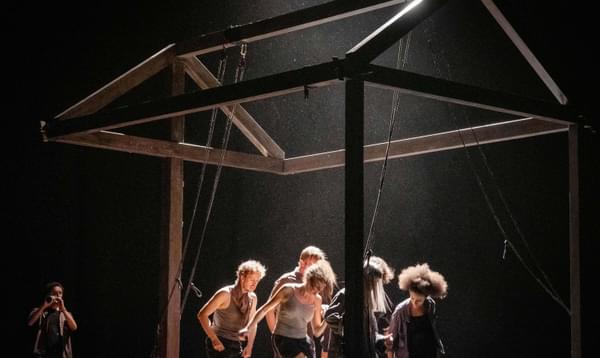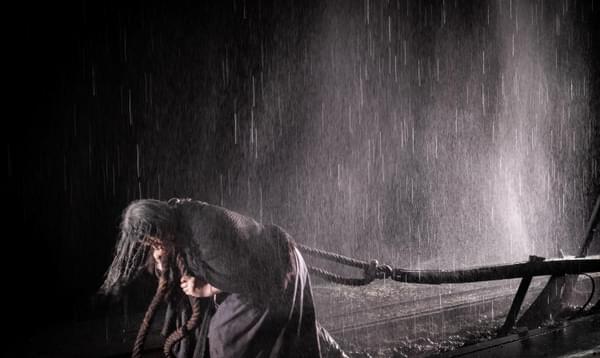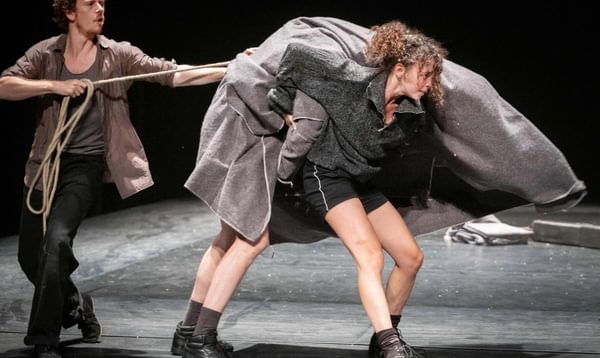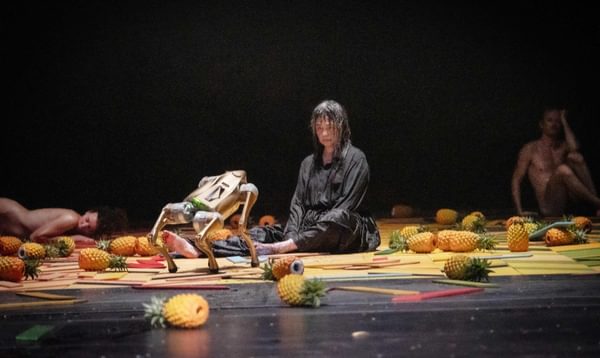
Works and Days
Works and Days
UK PREMIERE
FC Bergman's latest piece reckons with what is lost when our bond to the earth fades.
Birth, life and death converge at the heart of this visually spectacular performance, as theatre collective FC Bergman seeks the truth about our place in the wider world. Their latest wordless piece blends stunning imagery, movement and music to explore our connection with the land we inhabit.
Journeying from ancient times to the present, the play cycles through the seasons and fundamental human rites of passage. The ingenious set design exposes the actors to all the elements – from fire to water. The magnificent visuals nod to famous pastoral paintings, all told with FC Bergman's signature humour and pathos.
Accompanied by on-stage musicians playing original music inspired by Antonio Vivaldi’s The Four Seasons, the performance transports you to a time when the land was everything, and our existence was inseparable from it.
FC Bergman is a company unafraid to go big and bizarre with its gestures, tableaus and design
Listen on Soundcloud or Spotify.
Supported by Sir Ewan and Lady Brown
Programme
A keepsake freesheet is available at the venue for this performance.
Production Credits
CastCloseOpen
- Stef Aerts
- Joé Agemans
- Susan De Ceuster
- Geert Goossens
- Fumiyo Ikeda
- Maryam Sserwamukoko
- Thomas Verstraeten
- Marie Vinck
Creative & Production TeamsCloseOpen
- Stef Aerts, Joé Agemans, Thomas Verstraeten & Marie Vinck (FC Bergman)Directors, Dramaturgs & Set Designers
- Joachim Badenhorst & Sean CarpioComposers & Musicians
- An d’HuysCostume Designer
- Stef Aerts, Joé Agemans & Ken HiocoLighting Designers
CreditsCloseOpen
- Co-produced with Piccolo Teatro di Milano – Teatro d’Europa and Les Théâtres de la Ville de Luxembourg.
Dive Deeper
Listen to The Warm Up: your audio introduction to the performance.

By Josephine Balfour-Oatts
Josephine Balfour-Oatts is a transdisciplinary English Literature PhD researcher at the University of Edinburgh. She works as a Teaching Assistant on the Narrative Futures MSc at the Edinburgh Futures Institute and contributes to the TLS and the Scotsman as a cultural critic.
A Living Painting
Founded in 2008, Flemish theatre collective FC Bergman are renowned for utilising a range of cinematic, literary, and art historical references to build the aesthetic worlds of their performances. In the case of Works and Days, land art (artworks that are made in, or sculpted into, the landscape) and conceptual art (a movement with no specific form or style, valuing the artistic process over the finished, saleable art object, from which land art arises) converges. The company considers the crisis of modernity – namely, our disconnection from the land through farming – using an imaginary agriculture. As the company ploughs the floor of the stage, splintering then breaking its boards, the land appears to its audience as a memory. The cast are not sowing seeds; they are reaping what they sow.
Told entirely without words, Works and Days might be described as a living painting. Certainly, the pastoral genre contributed to the visual palette of the piece, and the title also recalls the didactic poem of the same name by Ancient Greek poet Hesiod in 700 BC, which is notable for its status as a farmer’s almanac. What is informed by poetry and painting is transformed into gesture and song: as with land artists such as Richard Long who, in A Line Made by Walking (1967), intervened in the landscape by making a mark in the earth through walking up and down, theatre as a form is ephemeral. Like a season, or a continuous line worn into a field of grass, performance is a temporary intervention.
Initially, proximity and togetherness are achieved through ensemble-driven scenes – driving a plough, threshing, building a house, dancing around a campfire – and these evoke paintings such as The Wedding Dance (1566), one in a jubilant trilogy of works by the Netherlandish Renaissance artist, Brueghel, who FC Bergman have highlighted as a source of inspiration in an interview with the Scotsman theatre critic, Joyce McMillan. In The Pastoral Concert (c.1509) by Italian Renaissance artist, Titian, two nude figures exist unseen by a party of three. Works and Days provides an inversion of this image, as after completing a neolithic fertility ritual, a nude couple are offered a post-coital, and anachronistic, cigarette by three invisible figures. Additionally, in the original, one nude and one clothed figure plays a flute and lute respectively, echoing the role of musicians Joachim Badenhorst and Sean Carpio as they respond live to the action onstage. Somewhere between actor and audience, they improvise phrases of jazz reminiscent of Antonio Vivaldi’s Four Seasons.
Each beat moves quickly and interconnectedly, so that the boundary between seasons blurs. The audience witnesses the life cycle – chicken, egg, cow, calf, young, old – and when the neolithic couple draws cigarette smoke into their lungs, they beckon the Industrial Revolution, and future generations of farmers and agricultural equipment, into being. While L.S. Lowry’s Industrial Landscape(1934-55) lacks the hot, raw appeal of machine technology in Works and Days, this painting highlights the pace of change that its invention brings. Onstage, seeds turn to ash. The cigarette, locomotive – and the chimneys that populate Lowry’s work – assume the same phallic shape, as male-bodied cast members dominate the stage and the new world of industry.
Until now, humanity has survived by working together, but as the end of the play nears, the cast become increasingly individualistic and alone. A woman attempts to gather a harvest on her own in the rain, her anguish the antithesis of the states of joy and abundance that characterise earlier group scenes. When the sun rises, a new dawn draws her into the future. In the timeline of the piece, technicolour seeds, crops, and leaves had once mixed harmoniously. Here, colours are arranged into a spectrum, orderly as shelves in a supermarket. Pineapples spring from the earth independently, a tribute to the audience’s reduced knowledge of, and connection to, the food that they buy. As the woman looks on, the effect is not unlike Flora Yukhnovich’s painting Warm, Wet N’ Wild(2020), which shows nude bodies lounging easily yet extravagantly in grassland. Indeed, the image could have been painted from the point of view of this woman in Works and Days, her vision swimming as she moves, hungrily, towards the light.
© Josephine Balfour-Oatts 2025
Image gallery
Photo Gallery






© Kurt Van der Elst
